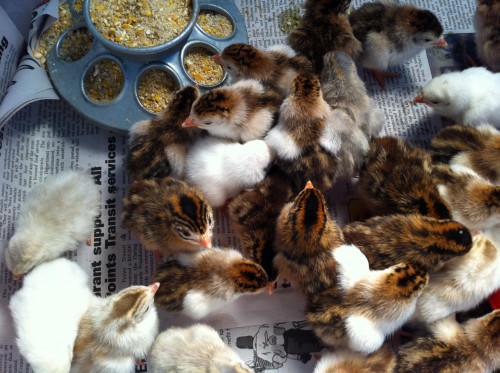One of my hens recently hatched a couple chicks. The one that survived is now a few weeks old, and I have no idea if it’s female or male. It’s not that I don’t want to know. It’s just that it’s surprisingly difficult to distinguish the two sexes when they’re young.
There are two ways to sex a hatchling: by flipping it upside down to examine its cloaca — the vent where its genitals and anus open — or by examining its wing feathers. The second method is more straightforward, but it only works on a select number of chicken breeds, so the cloaca method remains the standard.
The Japanese famously perfected the art of chicken sexing. While pressing the chick just so, the sexer looks for a tiny bump at its vent. If it’s there, the chick is most likely male. But chicken genitals are variable, and distinguishing male from female takes hours and hours of practice.
During the 1930’s, 40’s and 50’s, second-generation Japanese Americans (called Nisei) became renowned for their chicken sexing skills. Their expertise was in high demand, because commercial poultry operations separate out the sexes early on to ensure that future laying hens receive different feed and care from cockerels.
A professional chicken sexer might sort 800 to 1200 chicks per day, with more than 98 percent accuracy. How do they do it? The technique is such a mystifying art that even the world’s best chicken sexers can’t explain precisely how they do it.
In his paper The art of chicken sexing, Richard Horsey quotes a chicken sexer explaining it thusly:
Intuition comes in to play in many of your decisions, even if you are not consciously aware of it. As one of my former colleagues said to me…‘There was nothing there but I knew it was a cockerel’.
A 1987 study found that indeed, professional sexers could distinguish even subtle and rare differences between the vents of males and females. But the same study also found that novice sexers who were given detailed instructions about what to look for could significantly improve their performance. The paper’s takeaway is found in its title — sexing day-old chicks is a difficult perceptual learning task. It’s probably true that the best sexers determined a hatchling’s sex without too much conscious, deliberate thought, but what felt to them like intuition was most likely their brains culling the available perceptual information and comparing it to previous experiences to make a snap judgment.
The process apparently becomes addictive (or at least compulsive) in some. Richard Horsey’s paper quotes R.D. Martin, author of the Specialist Chick Sexer saying,
If I went for more than four days without chick sexing work I started to have ‘withdrawal symptoms’. Several of my students have expressed the same feeling when they have not sexed chickens for a week or so.
I’m not sure I want to become addicted to chicken sexing, but I wouldn’t mind watching a master at work. One of these days I’ll convince an editor to send me to chicken sexing school. Until then, I’ll just have to watch and wait.
*Photo of chicks and guinea keets by Christie Aschwanden

What fun! I did a story in about (gulp!) 1982 for Science Digest magazine about how the modern chicken had been engineered beak-to-butt by poultry scientists. I ran into the chicken sexing issue, but only had a paragraph or two about it because the lucrative chick-sexing industry in the mid-Atlantic states where I lived was completely controlled by a very secretive group of Korean-Americans and I could only get one of them to talk to me, by telephone and not in person, and he was so heavily accented I wasn’t really sure what he was saying. Glad to see things are more out-in-the-open these days!
Hi, Joanne. Are you telling me that if these secret guys ever did teach Christie how to sex chicks, they’d have to shoot her?
I know Tom Whiting at Whiting Farms outside Delta does a lot of chicken sexing. I imagine he’d consider letting you sit in and watch the process. He also raises quite a lot of roosters for their tail feathers – a fairly controversial practice in terms of animal rights. Might make an interesting story.
Great idea, thanks for the suggestion Laurel.
I did go to the link for the Chicken Sexing School, but mostly for tuition fees since I was just curious to see if it was the same for butler schools…
I had thought your 800 to 1200 a day seemed low, and it was. Those numbers are per hour. Which is vastly more impressive. I have seen videos of sexers and it takes scant seconds for them to pick a chick, squeeze the poop out of it (into a big bucket just for this purpose ( ew )) , take a look and toss in the appropriate bin.
That should make it around 8000 a day which is an amazing level of concentration, and chick poop.
After seeing that I started squeezing fish before cleaning, and that got rid of that little problem.